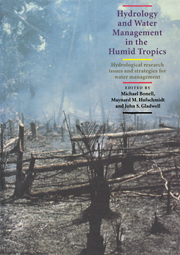 Hydrology and Water Management in the Humid Tropics
Hydrology and Water Management in the Humid Tropics Book contents
- Frontmatter
- Contents
- List of Authors
- Foreword by Federico Mayor, Director-General, UNESCO
- Preface
- Cartographic Credit
- Acknowledgements
- SECTION I INTRODUCTION
- SECTION II HUMID TROPICS SETTING
- SECTION III REGIONAL HYDROLOGY
- 5 Hydrology in Humid Tropical Asia
- 6 The Hydrology and Water Resources of Humid Northern Australia and Papua New Guinea
- 7 Hydrology and Water Resources of Tropical Latin America and the Caribbean
- 8 Amazonia Rainfall and Its Variability
- 9 Regional Hydrology and Water Resources in the African Humid Tropics
- 10 Review of Hydrology and Water Resources of Humid Tropical Islands
- SECTION IV PHYSICAL PROCESSES
- SECTION V PHYSICAL PROCESSES – HUMAN USES: THE INTERFACE
- SECTION VI MANAGEMENT ISSUES
- SECTION VII APPENDICES
- Place index
7 - Hydrology and Water Resources of Tropical Latin America and the Caribbean
Published online by Cambridge University Press: 23 December 2009
- Frontmatter
- Contents
- List of Authors
- Foreword by Federico Mayor, Director-General, UNESCO
- Preface
- Cartographic Credit
- Acknowledgements
- SECTION I INTRODUCTION
- SECTION II HUMID TROPICS SETTING
- SECTION III REGIONAL HYDROLOGY
- 5 Hydrology in Humid Tropical Asia
- 6 The Hydrology and Water Resources of Humid Northern Australia and Papua New Guinea
- 7 Hydrology and Water Resources of Tropical Latin America and the Caribbean
- 8 Amazonia Rainfall and Its Variability
- 9 Regional Hydrology and Water Resources in the African Humid Tropics
- 10 Review of Hydrology and Water Resources of Humid Tropical Islands
- SECTION IV PHYSICAL PROCESSES
- SECTION V PHYSICAL PROCESSES – HUMAN USES: THE INTERFACE
- SECTION VI MANAGEMENT ISSUES
- SECTION VII APPENDICES
- Place index
Summary
ABSTRACT
This chapter reviews briefly the hydrology and water resources of the humid tropic regions of Latin America and the Caribbean, following generally the definition of Chang and Lau (see the appendix to this book). For each subregion (Central America, Caribbean Islands and South America) descriptions of the climate, geomorphology and surface and groundwaters are described. It is concluded with a call for additional detailed assessments of the water resources of each country.
INTRODUCTION
The region under discussion in this section is that of the humid tropics as defined by Chang & Lau (1983). Figure 1 shows the areas of tropical Mexico, Central America, the Caribbean and tropical South America that are of concern.
The tropical regions of Latin America and the Caribbean are probably the most humid of the world. South America, for example, has some of the highest rainfall and runoff of any continent. Because most of the rivers of the region are rainfed, the seasonal distribution of the discharges is often directly related to the rainfall distribution. In the northern hemisphere, the incidence of tropical hurricanes can confuse the regionality of the rainfall amounts because of the non-uniformity with which the islands and mainland are impacted by these cyclonic events. Throughout the mainland of Latin America, the major physiographic factor affecting the water resources is the mountain chain that runs all the way from Mexico to Chile. This causes the rivers generally to be longer and larger on the Atlantic side (and contain some 84% of the land area), and shorter and with much higher gradients on the Pacific side.
- Type
- Chapter
- Information
- Hydrology and Water Management in the Humid TropicsHydrological Research Issues and Strategies for Water Management, pp. 84 - 98Publisher: Cambridge University PressPrint publication year: 1993
- 5
- Cited by


